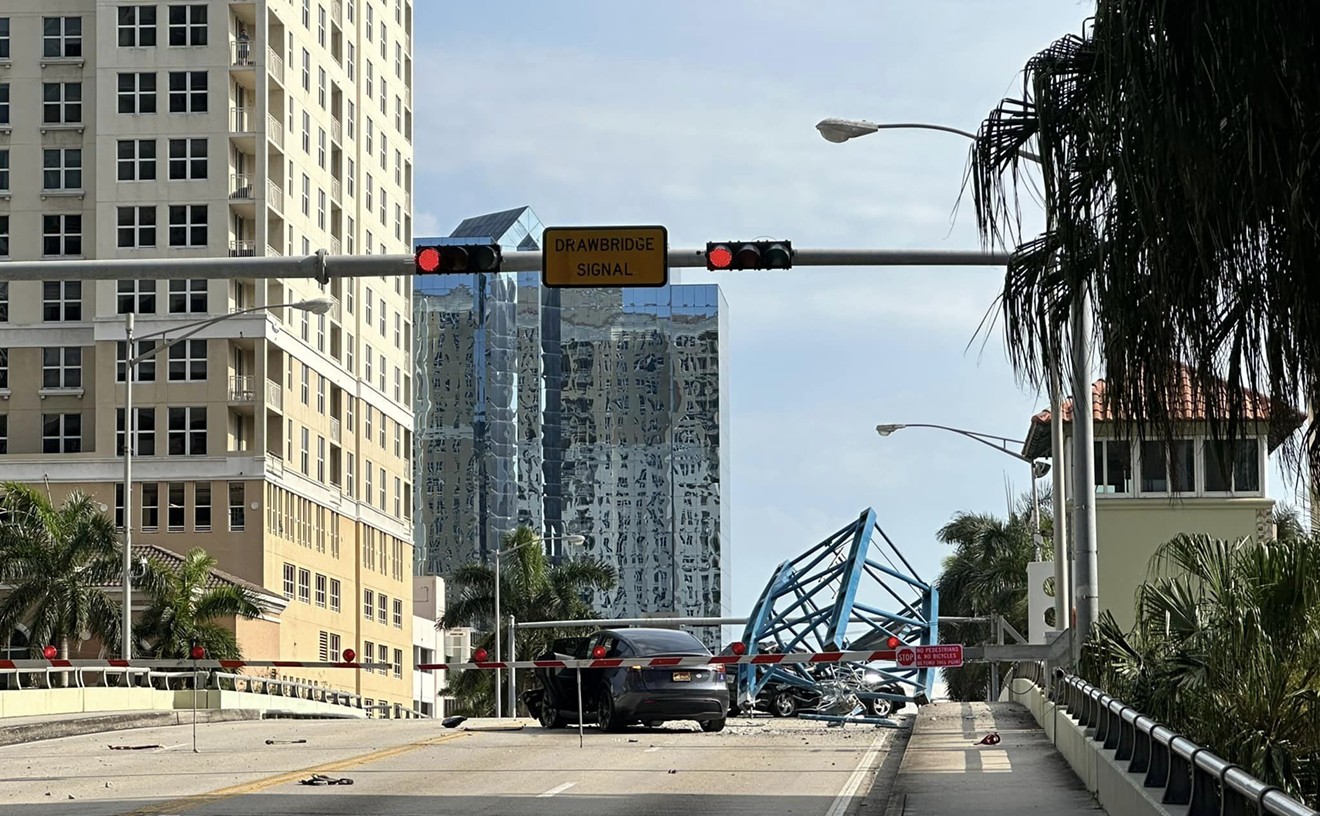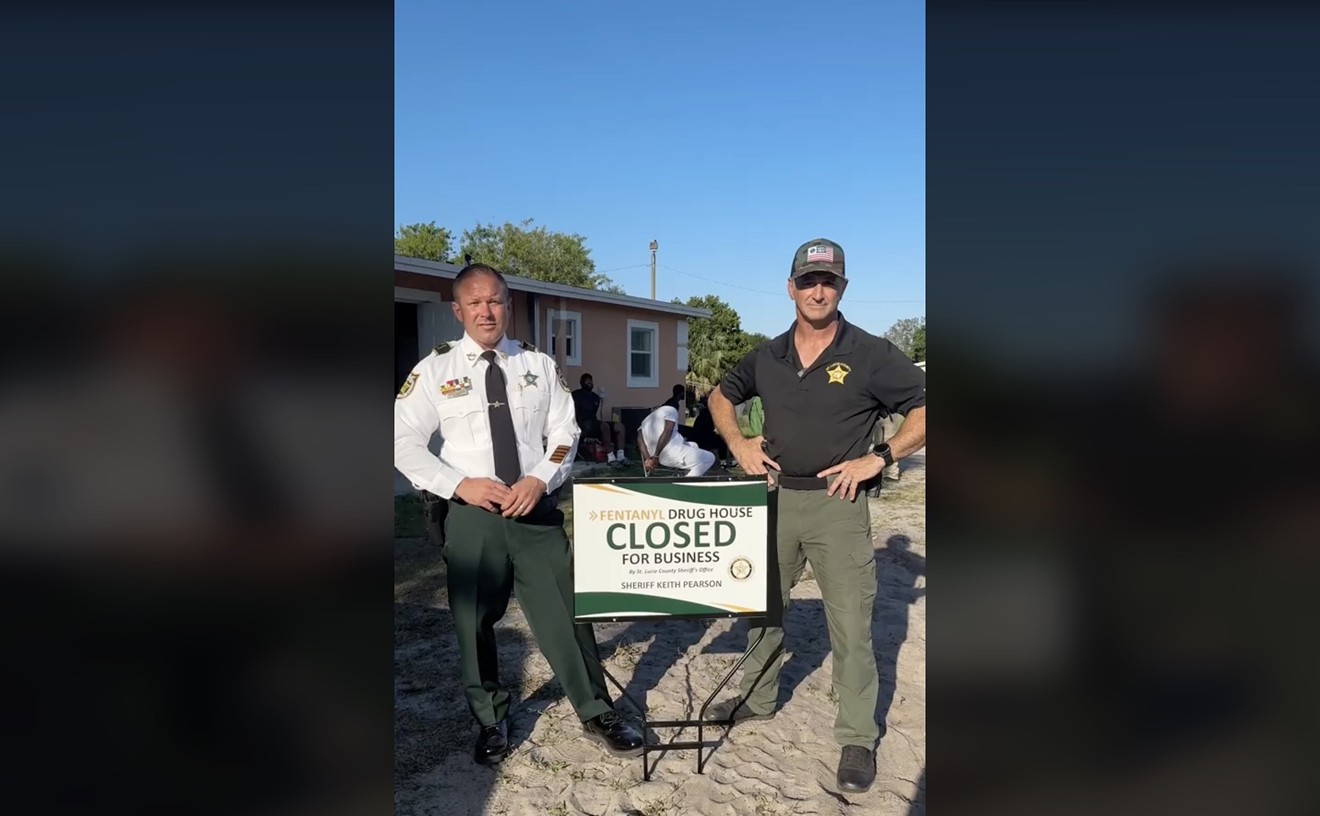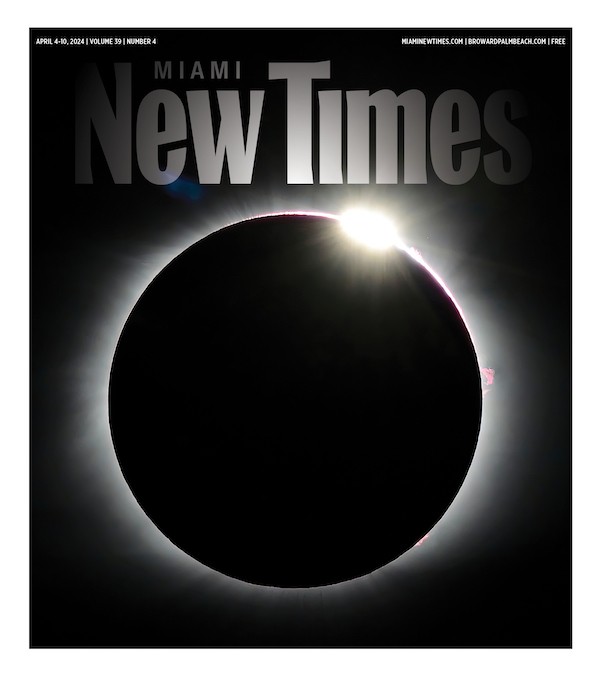Before Taylor could cross Independence Avenue, Hector Alcalde, a lobbyist whose clients included the International Council of Cruise Lines (ICCL), approached. "He did the typical flattery stuff -- 'You knocked 'em dead in committee, we want to get to know you, we don't feel you understand our industry,'" Taylor recalls. "And then came the punch line: 'We want to give you and your family a free cruise so you can get to know us better.'
"I tell you, I was appalled at the blatancy of what I felt was an attempt to bribe me to back off," Taylor says. "And this just happened to be the day I was walking across the street to pass the bill.... I was furious. I said, 'Listen, buddy, I'm going across that street, I'm going to cut out your freaking loopholes, and I'm going to enjoy every moment of it." Taylor also remembers telling Alcalde to do something with the complimentary cruise.
On September 22 the House passed the bill. But the Senate later gutted it. "Nothing happened on the cruise-to-nowhere side. Finally it dawned on me: I wonder if I'm the only guy he's offered a free cruise to." Taylor eventually uncovered a list of fifteen legislators who had taken "fact-finding" cruises. Although Taylor now acknowledges that these little jaunts were not technically violations of ethics rules, he made a point of entering the names into the public record at a committee meeting. This episode, and the cruise industry's subsequent success on Capitol Hill, leads the congressman to declare that "what's best for them is worst for American taxpayers."
Alcalde did not return several phone calls seeking comment. Bankrolled by Carnival Corporation and its cohorts to the tune of $560,000 in 1998, lobbyists such as Alcalde have for years fought off lawmakers' attempts to impinge on the industry's smooth sailing to riches. Carnival, incorporated in Panama but headquartered in Miami, owns the world's biggest cruise business. The company's 45-ship fleet topped one billion dollars in profits in 1999, thanks to 2.4 million passengers.
The Arison family, which started Carnival, has made a bundle. How much? Recent estimates have placed the net worth of chairman and CEO Micky Arison at $5.1 billion, number 150 on the Forbes 400 list in 1999. He was valued at a comparatively paltry $3.5 billion the year before. Micky's father and Carnival founder Ted Arison was worth an estimated $5.6 billion when he died last year.
Yet, largely because of a loophole in federal law, the company pays just a pittance into public coffers. Other than about half a million dollars in annual property tax on its West Miami-Dade headquarters, and lease payments for its Port of Miami terminal, Carnival gives little to the county or state. Nor does it (or any other foreign-flagged cruise line) pay corporate income tax. On more than one billion dollars in profits last year, all of Carnival's fees (plus federal taxes on its Alaska-based tour subsidiary) totaled less than one percent of its profits. Had the 35 percent U.S. corporate tax rate applied, more than $358 million would have gone to the IRS.
The recently opened AmericanAirlines Arena represents another tax break for Micky Arison, who owns a controlling interest in the Miami Heat. The City of Miami, Miami-Dade County, and the State of Florida have granted the Heat $355 million worth of tax money, rebates, and property for the facility.
"Heck, it's just not fair," Taylor says. "They go buy their ships elsewhere, staff them with cheap, Third World labor, then enjoy all the benefits of doing business in America.... What if something goes wrong on those ships?" he asks rhetorically. "When their ships caught fire, did they sit around and wait for the Liberian Coast Guard to show up? What if there is a hostage situation? Will they call in the Panamanian Navy SEALs? Who incurs all of these responsibilities and pays all these costs? The American taxpayer."
For a man who made his fortune feeding America's appetite for leisure, Ted Arison lived life at a frenzied pace before he died last year at age 75. He launched several failed business ventures only to resuscitate his fortunes with boldness and luck. And perhaps owing to the near-disasters he faced so often in the boardroom, or maybe as a result of his years soldiering, the senior Arison was obsessed with his legacy.
"There were a lot of very sharp people in the early days of the cruise business," says Malcolm Noden, a senior lecturer at Cornell University's School of Hotel Administration. "Those people mostly went on their way, but a few remained, Ted among them. He survived to become 'legitimate,' but I'm not sure I would have trusted him to walk me across the street."
Ted Arison was born Theodore Arisohn in 1924, in Tel Aviv, then part of Palestine. He fought in the Israeli Army during that nation's 1948 war of independence, rising to the rank of colonel. When Israel nationalized its shipping industry (Ted's father Meir owned part of a shipping company and Ted worked in the family business), Ted Arison immigrated to the United States. He spent ten years in the air cargo business, including a stint with El Al Airlines, then moved from New York to Miami in 1966.
After only a few months in the subtropics, Arison hooked up with Knut Kloster, a Norwegian cruise-industry executive, to form Norwegian Caribbean Lines. With but one ship, the Sunward, the firm employed a new strategy that would redefine the industry: scheduling short Caribbean cruises rather than transatlantic hauls; marketing to middle America; and advertising the ships, rather than islands, as the destination.
In 1971 the Arison-Kloster partnership ended in an ugly lawsuit. When Kloster's share of the profits failed to reach $1.5 million two years in a row, he cancelled his contract. Arison then sued, alleging Kloster's Norwegian employees had caused the shortfall, at least partially, by purchasing furniture for the ships, then dumping it overboard. The dispute is described in Selling the Sea: An Inside Look at the Cruise Industry, a 1997 book by Carnival Cruise Lines president Bob Dickinson and former Florida International University professor Andrew Vladimir. The volume describes Ted Arison's next move as a gambit for financial survival: "Arison quickly moved to protect himself by seizing all advance money on hand at the various NCL sales offices around the country. He believed that the cancellation of his contract was not valid...." The lawsuit was eventually settled out of court, with Arison agreeing to return half of the funds he had seized.
Even before this settlement was reached, Arison put one million dollars in "seized" money to work starting a new cruise line, which he called Carnival. He joined forces with an Israeli friend, Meshulam Riklis, who put up seven million dollars to buy a ship called Empress of Canada. The vessel, renamed the Mardi Gras, was registered in Panama, which has no corporate income tax and does little to regulate labor practices.
On March 7, 1972, Ted took the Mardi Gras on its maiden voyage with 300 travel-industry professionals aboard. The boat immediately ran aground at Government Cut and remained there for a day. After being refloated the next day, she headed for San Juan, Puerto Rico, where Ted Arison made an alarming discovery: He didn't have enough money to pay for gas. Eventually he cleaned out some onboard cash registers to settle his bill.
The rough waters didn't end there. Mardi Gras's operating losses and other financial strife led Riklis to give Ted Arison the ship and its five-million-dollar mortgage in 1974 for one dollar. Arison slashed prices, then opened casinos and discos on board. Although Dickinson, who joined the company in 1973, is often credited with refining the "fun ship" concept that dominates Carnival's sales pitches, Micky Arison has stated necessity birthed that particular invention: "I'd love to say it was a grand strategy," Micky Arison told Florida Trend in 1989, "but in the early days, our only strategy was how do we make payroll?"
Carnival's idea caught on. "They attracted a generation who would not have chosen cruises, when the industry was geared toward people who wanted to play shuffleboard on the afterdeck," Malcolm Noden says. The wheeling and dealing that surrounded Carnival's birth, though, left Arison with a reputation. "The industry perception was that Ted was one of the smartest folks around and, in all candor, you'd have to sit on your wallet when you were talking to him. He was not considered to be someone whose ethics or morals you would take home to mother. It was a hand-to-mouth business, and he was one of the more slippery exponents of it."
In the mid-Seventies the company turned a profit for the first time and added a second ship, the Carnivale (another retread, formerly known as the Empress of Britain). In 1983 Carnival Corp.'s gross revenues were $221 million, and profits were $47.3 million. Except for a slight dip the following year, both total revenue and net income began a steady increase. In 1985 the company bought its first of three new, larger ships, adding one per year thereafter.
In 1989 gross revenues exceeded one billion dollars for the first time. Carnival's inexorable growth, at least in part, stemmed from labor efficiencies. "They achieved productivity through high-intensity effort, getting cabin attendants and food-and-beverage people to help do everything from moving baggage and loading ship's stores to polishing brass," Noden explains. Also helping the bottom line: Employees often worked 60 to 70 hours per week, were paid subminimum wages, and received minimal benefits.
Arison spread around some of his newfound liquidity during the Eighties. In 1989 he bought the seven-ship Holland America Line for $625 million, as well as three new $200 million superliners. On land he acquired two casino hotels in the Bahamas (the first of which he bought in 1983); an airline, which was added in 1988; and a hotel chain that spread from Alaska to Canada's Yukon Territory. Some of those holdings required Arison, for the first time in years, to shoulder a significant U.S. tax burden.
Indeed Ted Arison never did particularly well when it came to dabbling outside the cruise and hospitality industry. In the late Seventies he started an auto-loan underwriting firm that went out of business after just a few years. In 1979 he spent $12 million to form Hamilton Corp., a real estate firm, which a decade later (after correcting for inflation) was worth less than his initial investment. Arison sold out much of his interest in Hamilton in the early Nineties. He returned to the maritime cargo business in the Eighties, but lost $43 million before selling out in 1987.
Perhaps the biggest mess of his noncruise businesses was Ensign Bank, which he created by merging two smaller savings and loan institutions in 1983. In 1989 Ensign wrote off a three-million-dollar loan to CenTrust Bank chairman David Paul, who later was indicted and jailed for banking and securities fraud; then, on Arison's say-so, Ensign loaned $750,000 to Port of Miami director Carmen Lunetta for a real estate development. Finally Ensign lost more than $19 million in the first quarter of 1990, and by year's end, the federal government had seized it.
"There was a vision, but no plan [in Ted's business]," William Parkhurst, a former high-ranking Arison employee, told Florida Trend in 1989. "[His] style is intuitive management. Acquisitions were pursued opportunistically and on an ad hoc basis. There was no systematic approach."
Although cruise industry critics and activists had begun to chastise the company and its competitors for unfair labor practices, Ted managed to forge a reputation as Miami's Corporate Citizen Number One. Maurice Ferre, former Miami mayor and Dade County commissioner, alludes to Ted Arison's founding of the New World Symphony as a prime example of his civic activism. "Ted was a man who had been up and down in life, a self-made, extroverted type of person," Ferre comments. "I thought he was a wonderful guy. He was outgoing, but not loud, an insightful type of person. I think he was a man who was very good at judging people."
In 1990 Ted Arison retired from Carnival, renounced his American citizenship, and returned to Israel. He became active in Israeli charities and finance through a foundation he had started a decade before. In June 1994 the Arison Foundation gave four million dollars to the Tel Aviv School of the Arts. In 1997 Arison purchased control of the country's largest bank.
In 1996 Arison told a Broward County court that simply surviving until 2000 was his last goal. One reason: He wanted to keep Uncle Sam away from his estimated five billion dollars in personal wealth. Estate taxes in the United States run as high as 55 percent; Israel has no such levies. But to escape IRS clutches, a person must survive ten years outside the country. "All I know is my lawyer, he had told me ... 'You better live for ten years,'" he said in a deposition that was part of a civil lawsuit. "That's it. So I'm trying." He fell a few months short, succumbing to a heart attack in October 1999. Shortly after his death, the Arison Foundation donated ten million dollars to the King Hussein Cancer Research Center at a Tel Aviv hospital.
The first Miami Heat basketball game in the new AmericanAirlines Arena had a triumphal air. The most obvious signs of the occasion's significance, except for the jugglers and stilt-walkers outside, were the tuxedos worn by the sportscasters on WAMI-TV's (Channel 69) SportsTown.
During the pregame show, announcers Tim Ring, Brad Steinke, and Mark Jones led viewers on a tour of the nearly finished arena, from the cheap seats to the plush skyboxes. As the sportscasters' gushing kicked into high gear, the man most responsible for building the arena sat down for an interview.
Micky Arison seemed a bit uncomfortable holding his microphone, but he nonetheless looked dapper. His healthy tan was complemented by a close-cropped goatee, a knife-edge gray suit, and his gradually silvering hair. The multibillionaire exchanged pleasantries with Jones about the wonders of the arena. The building represents a "great partnership" between the Heat and Miami-Dade County, Arison said. Its skyboxes and maritime beauty would provide the Heat with "revenue streams to give us a huge boost," he added.
Then Jones lowered his voice a notch. "On a personal note, your late father Ted was very much responsible for basketball coming to South Florida. Is this part of his legacy as well? Do you share this with him in spirit?"
"Absolutely," Micky responded. "Obviously I wish he could have been here. He was planning on being here, but, um ..." He paused briefly, pursing his lips, then continued. "And uh, you know, what can I say. It's a shame he couldn't enjoy this with the rest of the family. Everyone else is here, enjoying it for him. And I'm sure he's with us in spirit."
Micky Arison was born in Tel Aviv, grew up in New York, and came with his family to Miami in 1966 as a teenager. He attended Miami-Dade Junior College (now Miami-Dade Community College), then the University of Miami. From there he went into the family business, working a series of two-year stints as a sales agent, a reservations manager, and a vice president. In 1979 Ted made 30-year-old Micky president and CEO of Carnival Corp. Ted finally passed the torch to Micky in 1990, resigning as chairman of the board.
In a 1996 interview with the Miami Herald, Micky described the differences between himself and his father thus: "Ted is more entrepreneurial, more creative. I am more administrative and competitive." Andrew Vladimir, the former FIU professor, has seen Micky's management style in action. "He's a delegator in general, but he operates with a great deal of information," Vladimir comments. "He's what I call a walk-around manager; he watches the ships, he watches where they're built, the ports. But he does delegate the decision-making." (Through the public-relations office of Carnival Corp., Micky Arison declined to be interviewed about his father's death, his family history, or anything else for this story.)
Micky's mettle would be put to the test immediately. When he took control, some financial experts questioned whether Carnival could maintain the spectacular growth it had enjoyed during Ted's reign. High fuel costs were making the industry nervous about the future. By late 1990 Carnival's stock was trading at $13 per share, down from $25 that June. Micky put on a happy face. "We are recession-resistant, not recession-proof," he said. Still, a 1990 story in Forbes predicted that "Carnival's party may not be over, but it is certainly quieting down."
Micky took the helm during probably the most challenging period in the company's history, asserts James Winchester, a cruise-industry analyst with Lazard Frere in New York. In 1991 Carnival Corp.'s profits dipped to $80 million because the company used much of its cruise-line profits to bail out the unprofitable Crystal Palace resort and casino, which it had built in the mid-Eighties. By 1992 profits jumped back up to $277 million, according to Winchester.
Micky also continued his father's strategy of acquiring other cruise lines. Carnival acquired Seabourn in 1992; a 30 percent stake in Britain's Airtours in 1996; Costa Crociere in 1997; and Cunard Line, Ltd., in 1998. (In a bit of historical irony, Carnival now appears poised to gobble up Norwegian Cruise Line. In the early Seventies, Ted Arison started Carnival with money he had seized from Norwegian's predecessor.) "Carnival has been adamant about keeping their different brands separate, not merging them into one amorphous cruise line," comments Laura Hughes, senior cruise editor with the weekly Travel Agent Magazine. "That's worked very well for them, because ... some clients want the large, traditional luxury cruise ship, some want the high-energy, more youthful experience, and some want the sailing cruise."
Despite his early success, Micky had his share of flops, especially the merger of his Carnival Airlines with Pan Am Airlines in 1997. After Pan Am declared bankruptcy in early 1998, Arison's $65 million stake in the carrier was worthless. In October Chief Executive magazine denounced Carnival's board of directors as one of the "Five Worst Boards" in the world. "It seems that most of our worst boards just don't get it," the article states. "They choose insiders and sycophants and beholden suppliers to be their directors instead of strong, competent, experienced people. They don't have women or minority directors. They like to have their relatives on board."
Chief Executive called Carnival a "family-dominated corporate maze." The magazine noted that nine of the sixteen board members are either family members, corporate officers in Carnival or its subsidiaries, or "representatives of services suppliers to Carnival.... This company ... should start cleaning up its act and instituting some effective corporate governance measures."
Nevertheless Micky's strategy received the ultimate benediction in 1996. "Micky made me more money than I ever made for him," Ted Arison told the Miami Herald. "I think he did a better job than I did."
The Arisons have been beating back a lot of fires lately. In July 1998 Carnival's Ecstasy steamed along Miami Beach, gushing smoke from its stern. In November of that year, the upper reaches of the AmericanAirlines Arena, which a firm controlled by Micky Arison manages, burned all day after some welders accidentally turned their torches on wooden shoring. Then blazes on the Tropicale (this past September) and the Celebration (January 12) frightened passengers and made headlines, though no one was hurt.
Numerous metaphorical conflagrations also have broken out, many of them following a series of New York Times articles by reporter Douglas Frantz titled "Sovereign Islands." Examinations of the cruise lines' mistreatment of foreign employees, the effects of the industry's tax-free status, and, perhaps most sensationally, the Jane Doe rape case, sparked criticism of the company and its competitors across the nation. Reports on the Jane Doe lawsuit drew the most ink after Carnival was forced to disclose there had been 108 cases of sexual misconduct, including 22 assaults by crew, against passengers on its ships during the past five years.
In a sworn deposition in the case, Carnival president Bob Dickinson said Micky Arison told him not to cave in to pressure from the plaintiff's lawyers. "[Micky] was concerned about the negative publicity attached to [the lawsuit and the disclosure]," Dickinson testified. "[Although] we felt we had a strong case ... I was given to understand that if we didn't settle the case quietly with Jane Doe, that there would be, in so many words, a PR circus." Industry analyst Jim Winchester downplays the financial impact of the incidents. "I don't think the publicity will impact the company's stock much," he comments. "Investors have put them in the correct context. They are something that needs to be fixed, but they are not a fatal flaw."
Tim Gallagher, Carnival Corp.'s vice president of public relations, thinks recent articles in the Times and other papers haven't treated Carnival or its competitors fairly. (The Miami Herald has published shortened versions of some of Frantz's stories.) He notes the Times declined to run letters written in response to the stories. "Obviously the New York Times editors do not want their potential Pulitzer nomination to be tainted by letters to the editor or op-ed pieces that question the accuracy and objectivity of the series," Gallagher scoffs.
"The greatest misconception this has created is that the cruise industry operates outside the laws of the United States," he continues. "Cruise lines have not obtained any special tax exemptions. They simply operate within the long-standing provisions that apply to all international shipping and air transportation companies." He adds that Carnival pays U.S. corporate income tax on its Alaska tour business and also on its operations in the United Kingdom, Italy, France, and Germany. (The U.S. levy came to $3.8 million in 1998, according to Carnival's annual report. Gallagher can't put a number on the foreign tax bills.)
The public expenditure that has most clearly benefitted the Arison clan isn't related to Carnival. It is the estimated $355 million the state and Miami-Dade County will shell out for the AmericanAirlines Arena, which opened last month in downtown Miami. The background of the deal shows the sway held by Micky Arison, who personally lobbied the county commission for the plan and spent millions selling it to voters.
Ted Arison first bought into the Miami Heat when the NBA awarded the city a franchise in 1987. In 1995 Micky Arison (by then in charge of the family business) bought out several partners and became the franchise's majority owner. Next Micky rammed an arena deal through the City of Miami and Dade County commissions that called for $115 million in public money and $50 million from the Heat.
In fall 1996 Alex Penelas, then a candidate to become the county's first executive mayor, capitalized on the outcry against the deal, railing that the public was being asked to pay too much. That position helped him win the election in October, one month before a referendum on the proposed arena. But Penelas quietly negotiated with Arison for a better deal, and scant days before the vote, he reversed his position and exhorted voters to back the facility. Along with confusing ballot language and Arison's $3.7 million of advertising, Penelas's support convinced voters to accept the idea.
But how good a deal was it? Jay Cross, the Miami Heat's president for business operations, responded in writing to a faxed question from New Times about the arena's financing. He pointed out that the public owns the building. "It was not given to Mr. Arison nor the Miami Heat," he stressed. The Heat, he continued, was responsible for financing the construction of the building, which cost roughly $213 million. In exchange the Heat would be allowed to operate the facility for 30 years. Cross contends the cost to taxpayers is $193 million, three decades worth of $6.4 million per year in operating subsidies.
He neglects to count $162 million, according to Bill Johnson, a special assistant to Penelas. That total includes county-donated land for the arena, street improvements, and a state sales tax rebate to the Heat, among other things. The grand total of public subsidies to the Heat for the arena is $355 million. For its part the county gets five percent of the arena's ticket sales as rent. Once the arena turns a profit, the first $14 million of profit goes to Arison. Only after that will the county get a 40 percent cut.
That level of public subsidy for a sports facility is about average for new arenas nationwide, says Andrew Zimbalist, a professor of economics at Smith College in Massachusetts. "What's unique about this deal is that, usually, the public money is put in up-front," Zimbalist comments. "Here, they've made this big elaborate procedure to make it look like it's privately financed.
"But to say that it's 'average' doesn't mean it's fair," he continues. "The average deal is very sweet for team owners, but that's the kind of leverage teams have when they have a monopoly; there's only one big basketball league." The large public expenditure, he adds, is hardly a guarantee of economic benefit to the community or even the neighborhood. The only person who benefits for sure: Micky Arison.
"It was a total bait and switch to the public," says attorney and activist Dan Paul, referring to the eleventh-hour deal between Arison and Penelas. "The Heat did not deliver on what they promised, and the county certainly laid back and let them do what they wanted. Now this big white tuna can is blocking the public view of bay. One of the most valuable pieces of downtown parkland is being used for a commercial purpose." Ted Arison (with wife Lin): His moxie, with taxpayers' help, built Carnival










